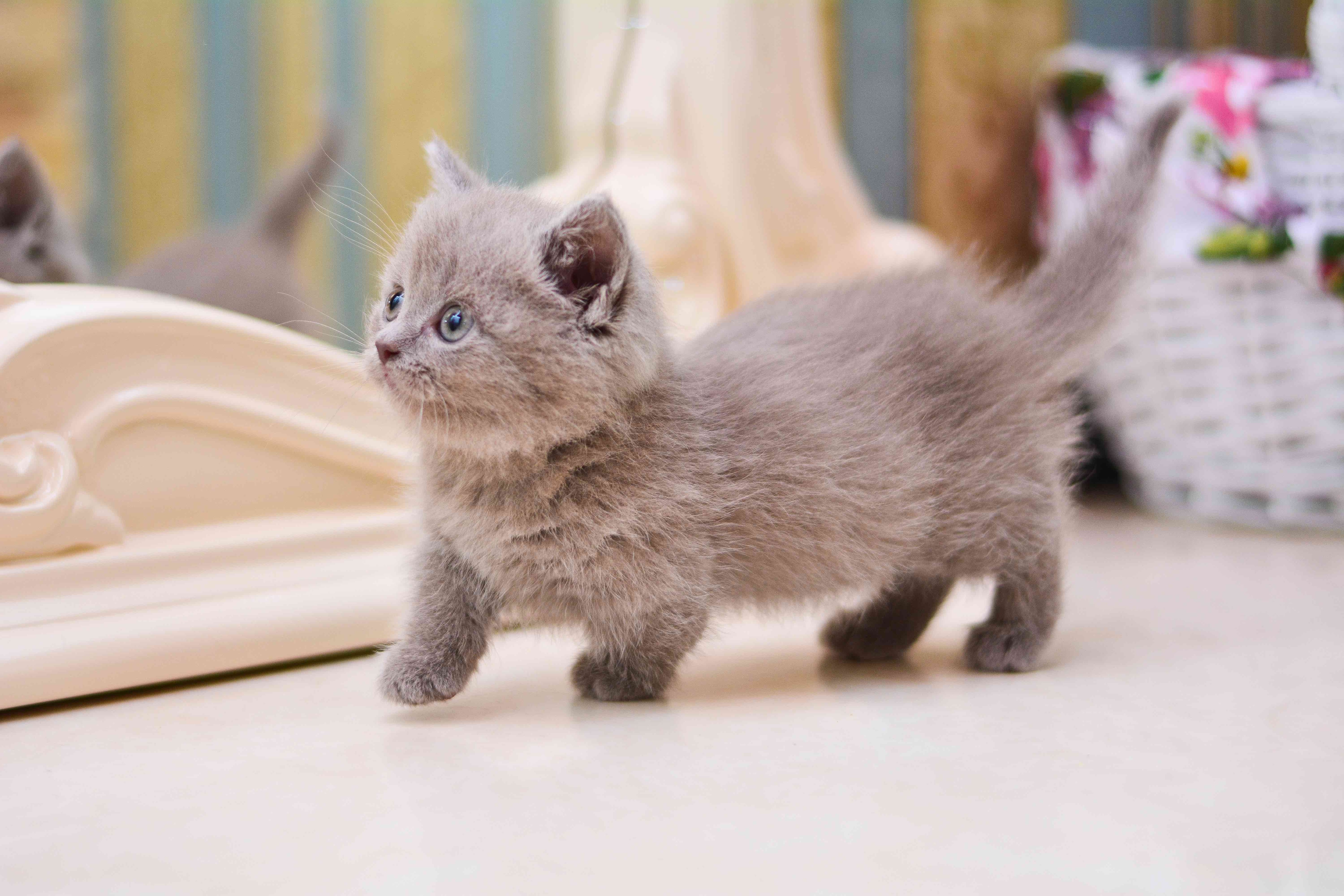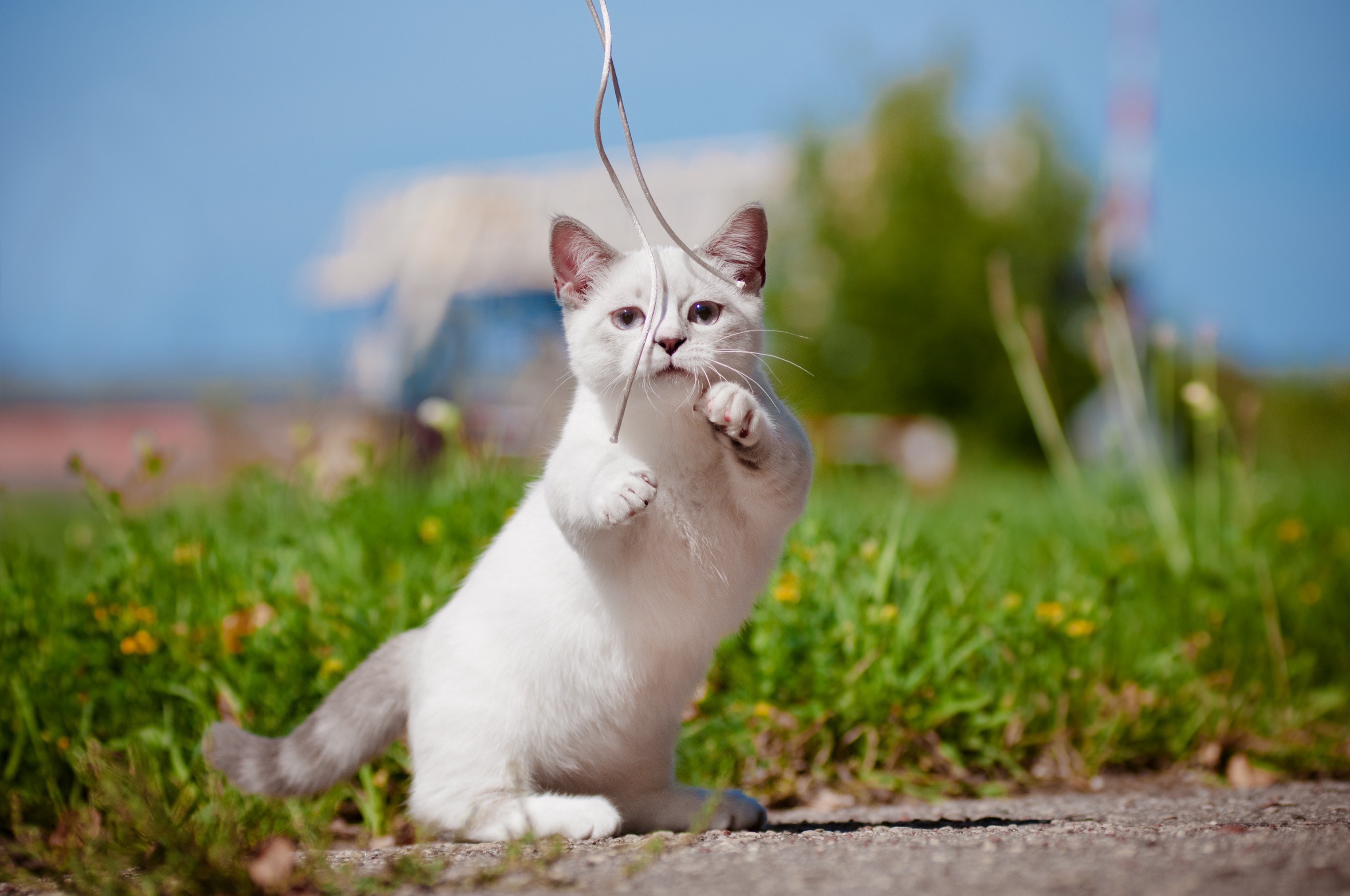Munchkin
The name isn’t the only adorable thing about the Munchkin. These playful, friendly cats have legs about 3 inches shorter than your typical cat. When paired with their average-size bodies (they generally weigh 6–9 pounds), this gives this dwarf cat a unique look, and their affectionate personalities are the cherry on top.
It’s worth noting that while some official cat breed organizations, including The International Cat Association (TICA), recognize the Munchkin as an official breed, others such as the Cat Fanciers’ Association (CFA) don’t. The reason: controversy over whether the mutation causing the breed’s short legs poses health risks.
Caring for a Munchkin Cat

A natural genetic mutation gives the Munchkin cat breed those short legs, but otherwise their build is quite average for a small cat.
“Munchkins are playful and kitten-like the majority of their lives,” says Dawn Lott, who in addition to breeding and showing Munchkins for 23 years, serves as TICA breed chair. She describes the friendly breed as attention-seeking and dog-like, adding, “They may follow you around the house a lot.” She recommends that pet parents with Munchkins have other animals at home that can keep their cat company 24/7.
In addition to their need for companionship, Munchkins are intelligent cats and enjoy toys and games. “Munchkins love to play with just about anything,” Lott says. “They are also known as thieves, as they will steal things off counters or dressers, and play with it until it disappears.”
While some people believe the Munchkin’s short legs prevent this breed from jumping to elevated surfaces, that’s not always the case—so don’t assume that enticingly shiny necklace on your vanity is out of reach.
Munchkin Cat Health Issues
The Munchkin is often a healthy, short-legged cat. Although the breed’s lifespan is pretty typical for a cat (around 12–15 years), there are health issues pet parents should watch for.
Because Munchkin cats are often so active, weight maintenance is typically not an issue. But for any Munchkins that develop the conditions below or experience limited mobility due to chronic pain, it’s especially important to keep an eye on their weight and body composition. With their short legs, any additional ounces can put more strain on their spines.
Osteoarthritis
The Munchkin cat’s short legs are the subject of some controversy, as the mutation that leads to their shortened limbs causes a defect in cartilage formation, says Paula Simons, DVM, an emergency and critical care resident at Cornell University Veterinary Specialists. That, she says, makes this breed predisposed to osteoarthritis and mobility issues. “Saying they can jump or run like a normal cat would be false,” she says.
If you notice your Munchkin refraining from running, jumping, or other favorite types of play, talk to your veterinarian about pain management options, including prescription medications and joint supplements.
Lordosis
Munchkins are prone to a congenital (present from birth) malformation called lordosis, an inward curvature of the spine in the lower back, says Simons. While some cats don’t seem to be affected by this downward curve, it can cause spinal pain, leaning to one side, and lead to reduced movement.
Pectus Excavatum
This congenital defect occurs when the last few ribs and sternum do not grow normally, leading to a hollowed-out chest appearance, says Simons. While present at birth, this condition is often not noticed until the cat is fully grown, at which time the defect stops progressing.
“This condition causes compression of the heart,” says Simons. “Mild causes of pectus excavatum may show no clinical signs, whereas severe cases lead to cardiac and respiratory issues. Surgery is often recommended in moderate to severe cases.”
What To Feed a Munchkin Cat

Munchkin cats do not have specific nutritional requirements, Simons says. “Ensure they are fed an Association of American Feed Control Officials-approved cat food appropriate for their life stage,” she says. Veterinarians often recommend a mix of wet food (which can help kitties stay hydrated) and dry kibble (to help reduce tartar buildup on their teeth).
How To Feed a Munchkin Cat
Feed your Munchkin a measured meal two to three times a day, using a life stage-appropriate food (kitten, adult, or senior). Do not free-feed a Munchkin cat, as this can lead to obesity. If they experience whisker fatigue with a bowl, a flat plate or mat may be preferable for some cats.
How Much Should You Feed a Munchkin Cat?
How much your Munchkin eats will depend on her weight, lifestyle, health, and other factors. Use the suggested servings on the cat food label as your guide for meal portions, but talking with your vet is best for determining how much food your cat needs. If your Munchkin becomes overweight, Simons suggests talking to your vet about a weight-loss diet.
Nutritional Tips for Munchkin Cats
Because the Munchkin can develop arthritis, Simons says it’s important to feed them a high-quality diet with supplements to support joint health.
Behavior and Training Tips for Munchkin Cats
Munchkin Personality and Temperament

“Munchkin cats are considered highly sociable, playful, and intelligent,” Simons says. “They make ideal family pets and are all-around good natured.” These are energetic cats that tend to get along with all members of the family, both humans and other pets. They generally enjoy a snuggle session, but only if they’ve had the opportunity to get some energy out first.
Munchkin Behavior
These short cats tend to be confident and outgoing pets that have no qualms about exploring their environment and making new friends. They’re not overly vocal, and while they aren’t anxious, they do enjoy company. If you’re away from the house a lot, consider getting your kitty a furry friend.
Munchkin Training
Lott says Munchkins are a smart, trainable breed. Munchkin kittens take to litter training quickly, especially when you reward them with cat toys and treats.
Fun Activities for Munchkin Cats
-
Playing with toys
-
Wrestling
-
Cuddling
-
Racing around the house
-
Jumping and climbing (especially on cat trees with low entry points)
-
Basking in the sun
Munchkin Cat Grooming Guide
Because Munchkins can have long or short coats, keep an eye on your Munchkin’s fur and brush her regularly to prevent mats or tangles. Fluffy Munchkins might need more frequent grooming than short-haired kitties, but in general, this breed has a low-maintenance coat.
Coat Care
Simons recommends that all cats, Munchkins included, be brushed weekly. And because they have short legs and can experience limited mobility due to osteoarthritis or lordosis, these miniature cats can struggle to groom themselves as thoroughly as most kitties. Keep an eye out for any areas they seem to be missing or unable to reach.
While bathing isn’t necessary, Lott says the occasional bath can help cut down on shedding, if that’s a particular concern. However, Munchkins do not shed more than your typical cat.
Eye Care
Munchkins don’t require special eye care, but contact your veterinarian if you notice signs of a potential eye problem, including discharge, swelling, or cloudy eyes.
Ear Care
No special ear care is required for Munchkin cats, but if you notice buildup, redness, or odor, talk to your veterinarian.
Considerations for Pet Parents
The appeal of a playful, fluffy Munchkin cat is undeniable. They’re adorable, friendly, and—as long as you don’t mind the occasional stolen earring or bauble—a joy to live with.
If you’re considering adding a Munchkin kitten to your home, talk to your breeder about the health of their cats. Be aware that, while most Munchkins have little to no trouble getting around like other felines, the mutation that causes their short legs can lead to other health issues.
Munchkin Cat FAQs
How much is a Munchkin cat?
Lott says the average price for a Munchkin cat is typically $1,000–$1,500. There may be variations depending on geographical location, coat color, and other factors.
Is a Munchkin a good house cat?
Absolutely! The Munchkin is a wonderful house cat that readily befriends everyone sharing her home. Whether you have an active house filled with pets and children or live a quiet life alone, the Munchkin cat can be a tremendous companion.
Are there hairless Munchkin cats?
The Bambino is a new cat breed that crosses the hairless Sphynx cat with a Munchkin to create a short-legged cat with no fur. The Cat Fancier’s Association, which does not recognize the Munchkin, considers the Bambino experimental and discourages the breed.
Featured Image: Adobe/otsphoto
